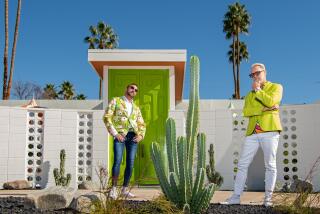Home of the Week: In Carlsbad, keeping a modernist vision intact
On a cul-de-sac overlooking the second hole of La Costa’s North Course, a late-1970s International-style home has been extensively remodeled with an eye for detail and a seven-figure outlay.
From the outside, the flat roof, cubic shapes, pure white exterior and series of tinted black-framed clerestory windows give the home a suspended-in-time appearance.
Donald Cromley designed the home for Bernard and Freeda Green in 1978. Their daughter, Susan, was a student of Cromley’s at the time and is also listed as an architect on the Carlsbad house. Currently an adjunct professor of architecture at Pratt Institute in New York, Cromley studied under Louis Kahn, whose architecture is noted for its simple, platonic forms and compositions.
The main structure consisted of a bedroom, living room, dining area, kitchen and master bedroom. It was connected by a covered walkway to a three-bedroom, two-bathroom guest wing. The Greens used the guest wing to entertain when La Costa hosted the PGA Tournament of Champions.
When Rick and Laurel Burrows bought the property five years ago, the home had fallen into disrepair.
“We lived in it for a couple of years before we settled on what we were going to do and how we were going to change it,” said Rick Burrows, a Wells Fargo brokerage manager.
In addition to connecting the two structures, their goal was to make the house more functional while keeping Cromley’s vision intact.
Leaks in the flat roof had damaged several sections of the dramatically angled red-cedar ceiling in the main house. Where possible, the owners added new wood to match the old. “A couple of spots were so bad, we faux painted them,” Burrows said.
When the roof was replaced, they added more light fixtures. Sconces replaced the original track lighting that ran along three sides of the catwalk, and Nelson Bubble lamps (a mid-century classic designed by George Nelson in 1947) bring more light to the space.
Floor-to-ceiling windows, bought from the same East Coast manufacturer that supplied the original windows, were installed to provide better views of the golf course.
Stairs lead up to the catwalk, which overlooks the living room, dining area and kitchen. A series of clerestories wrap around three sides. With no window coverings, shafts of light stream through, creating a striking effect.
A combination of oak, carpet and porcelain tiles replaced more than 3,000 square feet of the terra-cotta-tiled flooring that had been stained or damaged since the home was built.
In the recreation area, an angled wall of built-in oak cabinets was refinished. “Trying to get the old wood to match the new wood was a significant challenge,” Burrows said.
The kitchen is a long alley that features an black-granite countertop over quartersawed red-oak cabinetry with no handles, a backsplash made of red and white handmade ceramic tiles and a commercial-size exhaust hood. A walk-in pantry was once the laundry room. Staying true to the design, there’s no ornamentation.
Several pieces of furniture were custom made for the house, including a marble dining table weighing about 600 pounds that is supported by teak dowels, as well as tables and beds.
Repetition of size plays into design as well: Three of the four bedrooms measure 16 by 12 feet; the living room consists of three 16-by-16-foot squares.
To submit a candidate for Home of the Week, send high-resolution color photos on a CD, caption information, the name of the photographer and a description of the house to Lauren Beale, Business, Los Angeles Times, 202 W. 1st St., Los Angeles, CA 90012. Questions may be sent to homeoftheweek@latimes.com.






